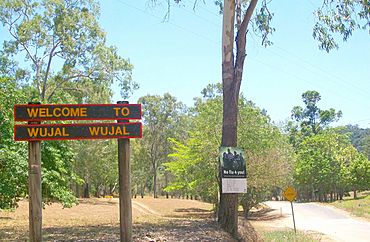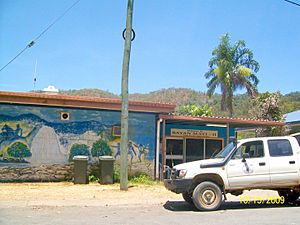Wujal Wujal facts for kids
Quick facts for kids Wujal WujalQueensland |
|||||||||||||||
|---|---|---|---|---|---|---|---|---|---|---|---|---|---|---|---|

Sign welcoming people to Wujal Wujal, having travelled from the south along the Bloomfield Track
|
|||||||||||||||
| Population | 276 (2021 census) | ||||||||||||||
| • Density | 23.59/km2 (61.1/sq mi) | ||||||||||||||
| Postcode(s) | 4895 | ||||||||||||||
| Area | 11.7 km2 (4.5 sq mi) | ||||||||||||||
| Time zone | AEST (UTC+10:00) | ||||||||||||||
| Location | |||||||||||||||
| LGA(s) | Aboriginal Shire of Wujal Wujal | ||||||||||||||
| State electorate(s) | Cook | ||||||||||||||
| Federal Division(s) | Leichhardt | ||||||||||||||
|
|||||||||||||||
Wujal Wujal, sometimes called Wudjil Wudjil, is a small town in Queensland, Australia. It is a special place for Aboriginal people. In 2021, about 276 people lived here.
Wujal Wujal is in the Cape York region. Many people visit this area to see its beautiful nature and learn about its culture. The town is part of the traditional lands of the Eastern Kuku (Goo-goo) Yalanji (Ya-lan-gee) people.
The name Wujal Wujal means 'many falls' in the local language. Several Indigenous languages are spoken in this community.
Contents
Exploring Wujal Wujal's Location
Wujal Wujal sits on both sides of the Bloomfield River in northern Queensland.
It is about 30 kilometers (19 miles) north of Cape Tribulation. It is also about 60 kilometers (37 miles) south of Cooktown. You can get to Wujal Wujal from Cooktown on a sealed road. From Cape Tribulation, you can take the Bloomfield Track. This road is unsealed and needs a four wheel drive vehicle. It has steep parts and many small rivers to cross. When it rains a lot, the road from Cape Tribulation can become impassable.
Unique River Animals
The rare Bloomfield River Cod (Guyu wujalwujalensis) lives only in the Bloomfield River. This fish is named after the Wujal Wujal community.
A Look at Wujal Wujal's Past
The Kuku Yalanji language is spoken in areas like Mossman and Daintree. This language region includes places like Wujal Wujal.
Early European Visits
The first Europeans to visit the Bloomfield River were Frederick Bedwell and Phillip Parker King in 1819. They were exploring the coast. Later, in 1872, William Hann explored the Cape York Peninsula. He was looking for minerals and land. Hann's group discovered gold on the Palmer River.
This gold discovery led to a big gold rush. By late 1873, many miners and officials arrived. The town of Cooktown was started in 1874. Its population grew quickly, with many Chinese immigrants.
Challenges and Changes
Early interactions between European settlers and the local Aboriginal people were sometimes difficult. In the 1870s, there were many conflicts in the region.
Over time, the government's approach changed. Instead of conflict, Aboriginal people were encouraged to move to missions. These missions were meant to provide a place for Aboriginal people to live.
In 1885, a Lutheran missionary named Johann Flierl helped set up a mission at Bloomfield River. This mission was on land reserved for Aboriginal people. Frederick Bauer was the first leader, followed by Carl H Meyer and Sebastian Hoerlein.
The mission faced challenges. The number of people living there changed often. The local Wujalwujalwarra people used the mission for resources like food and tools. They also used it as a place to care for the elderly, sick, and young. However, the mission did not always fit their traditional way of life.
In 1902, the mission closed down. The Aboriginal people who had been there stayed in small camps nearby.
Re-establishing the Mission
In 1957, concerns were raised about the health of children living in the camps. The Lutheran Church was asked to re-establish the mission. An area was set aside as an Aboriginal reserve in 1958.
In the 1960s, the mission had three main villages. A girls' hostel was built, and later, all the camps were brought together into one main area.
Recent Events
In December 2023, the area was hit by the 2023 Cairns floods. About 270 Wujal Wujal residents had to be evacuated. Many homes in the town were flooded when the Bloomfield River overflowed.
Community Life in Wujal Wujal
Wujal Wujal was once known as the Bloomfield River Mission. The people here are Kuku Yalanji. The community is thought to have lived on this site for thousands of years. It is built around the very special waterfalls of Wujal Wujal.
The community has a helicopter landing pad near the hospital. Health services are provided by nurses and health workers. Doctors from Cooktown Hospital visit a few times a week.
In 1980, the Aboriginal Council was formed. The area then got its traditional name, Wujal Wujal. The community also has an Indigenous Knowledge Centre called Binal Mangka Bayan. This means "house of knowing things." It offers books, magazines, and programs for all ages. Internet access is also available.
Learning and Education
There is no school directly in Wujal Wujal. The closest primary school is Bloomfield River State School in nearby Bloomfield. For high school, students usually attend boarding school or use distance education.
Things to See and Do
The waterfalls in Wujal Wujal are very sacred to the community. For cultural reasons, only one waterfall is open to the public. Other waterfalls are reserved for the women of the local community.
You can take tours to Wujal Wujal in four wheel drive vehicles from Cairns and Cape Tribulation. These tours use the Bloomfield Track.
Since 2003, the Walker family, who are Kuku Yalanji people, have offered rainforest tours. They share their traditional country at Thompson Creek, about 6 kilometers (3.7 miles) south of Wujal Wujal. They have also added guided walks to the Bloomfield Falls.




